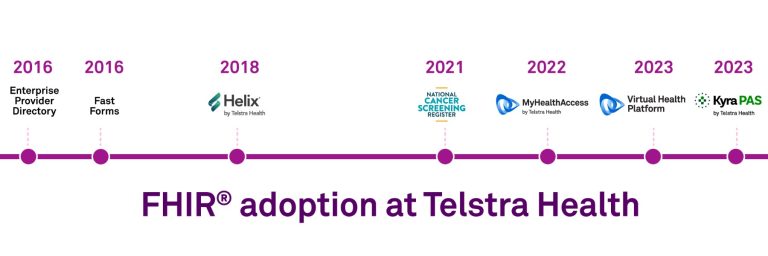Telstra Health appoints Dr Janice Tan as Clinical Director
General Practitioner and digital health expert, Dr Janice Tan, has been appointed Clinical Director at Telstra Health.
Tell me more
Author: Jane Gilbert, Integration Lead, Enterprise Technology, Telstra Health
FHIR enables the exchange of healthcare information between different electronic health systems, making it possible for healthcare providers to seamlessly share patient information across different platforms and organisations. The interoperability that FHIR enables is essential for providing high-quality care to patients, reducing errors and redundancies, and improving the overall efficiency of the healthcare system. FHIR is helping to shape the future of connected healthcare.
At Telstra Health, we focus on a data-driven, rather than document-driven approach to sharing information. We believe that FHIR is core to digital connectivity across care settings which is why we have a robust program of FHIR standards adoption across our entire ecosystem of solutions, software and services.
We know that FHIR standards will not only more readily enable clinical semantic interoperability, but they also help to accelerate the opportunity for analytics and data-driven insights.
Our unique footprint connects across the broad healthcare ecosystem. The breadth, depth and scale of Telstra Health and partner solutions provides us with an opportunity to solve many complex problems that span across multiple segments or within new markets. Our enterprise vision is to enable connected healthcare solutions through timely, accessible and secure health information, built upon a foundation of common components, standards and partner capabilities.
Telstra Health has been a leader in FHIR adoption since 2016, in which we used early versions of FHIR to develop the Enterprise Provider Directory (EPD). This was one of the earliest applications in Australia that was built entirely on FHIR standards.
Our EPD solution helps hospitals and large health services to centralise and manage provider, service and organisation details across multiple information systems and automatically update these with national directories. EPD is compliant with HL7 standards and has FHIR-based Application Programming Interfaces (APIs) to support current and future interoperability.
FHIR-enabled systems are core to enabling our health system to remain sustainable in the face of the emerging trends we are seeing across the healthcare system in Australia and globally. These include:
An ageing population and growing chronic disease burden which are placing a significant strain on the healthcare system;
Barriers to accessing healthcare and workforce shortages, particularly in rural or remote areas;
Emerging technology standards, data security and the slow rollout of systems that are interoperable; and
Empowering patients to manage their own health and wellness, and the increasing appetite towards patient-based care and preventative health.
The unique challenges that surface from these trends cannot be effectively impacted at a systems level alone; they require all areas of the healthcare system to operate in harmony. And interoperability is the driving force for making this to happen.
Telstra Health is responding to these trends by embedding interoperability standards across our enhanced solutions, platforms and services. We understand the importance of enabling an ecosystem that drives interoperability and puts the patient at the centre of care.
And while legacy systems and standards in Australia are tightly embedded in the healthcare ecosystem, FHIR-enabled systems can provide a means to transform and integrate them, eventually phasing them out.

Our EPD solution was just the start of our FHIR journey; since the launch of this, we’ve rapidly expanded FHIR across our digital health solutions, software and services to not only connect these but to enable integration with entire systems in the health and care sectors.
In primary care, our cloud-based specialist general practice management software, Helix, has been enabling partner integrations since 2018. We are continuing to invest in providing greater interoperability to Helix customers by utilising newer versions of FHIR and a Clinical Data Repository.
Telstra Health is also improving interoperability across some of the national services it manages, for example the National Cancer Screening Register (NCSR) which it operates on behalf of the Australian Government. The NCSR creates a single electronic record for eligible people participating in Australia’s bowel and cervical screening programs. Enabling FHIR integration has allowed seamless interoperability with systems used in primary and community care. For example, Communicare, Australia’s leading digital primary and community care solution for Aboriginal Community Controlled Health Organisations (ACCHOs), allows healthcare workers to securely access and submit cervical and bowel screening data for the communities they serve.
Broadening FHIR integration across other areas of Telstra Health’s ecosystem, in 2023 we introduced Australia’s FHIR-native virtual health platform – an enhanced virtual care platform for both healthcare providers and patients, regardless of their location. The Virtual Health Platform enables both exchange and storage of data utilising FHIR within a Clinical Data Repository and allows seamless integration with an Electronic Medical Record (EMR) or other clinical systems. The platform can be applied across a multitude of use cases, for example hospital in the home, and acute, sub-acute and chronic disease management.
When we consider the beneficial impacts of FHIR for our hospital system, Telstra Health recently introduced Australia’s first FHIR- native, mobile-enabled patient administration system, Kyra PAS, to help bridge siloed workflows between hospital departments and sites. and eliminate multiple data sources used within hospital settings. This helps to create more efficient workflows
The timeline on the left demonstrates FHIR adoption across Telstra Health’s ecosystem.
At Telstra Health we believe FHIR standards will become more commonplace with emerging and future models of care.
We are committed to building open, interoperable systems for solving the ongoing challenge of connected health. In fact, a core underpinning of our strategy in ensuring interoperability of our systems, is standards support, alignment and implementation.
To do this effectively we are working with key integration partners to uplift the use of FHIR in Australia while extending the existing FHIR capabilities which are currently available to our customers.
We are supporting the development of standards such as FHIR, SNOMED CT-AU and Australian Medicines Terminology (AMT) by working closely with the Department of Health and Aged Care, Australian Digital Health Agency and CSIRO. We are also collaborating across the health sector to identify priority implementation use cases that will support national health reform.
There are also lots of learnings from international work in this area. The International Patient Summary (IPS) is a patient summary technical specification for a set of basic clinical data about a patient which is specialty-agnostic and condition-independent, but readily usable by all clinicians for cross-border patient care. The IPS started as an initiative from the Joint Initiative Council for Global Health Informatics Standardization and has led to publication of a FHIR Implementation Guide specification led by the Patient Care Work Group in HL7 International. This specification may be further refined to make it suitable for creation of globally interoperable patient summaries in specific countries or regions. HL7 Australia supports adoption and implementation of the IPS in Australia. Telstra Health, an HL7 Australia Gold member, is actively involved in discussions to progress adoption of the IPS in Australia.
When we consider the varied ways in which we support our customers, we’re seeing a greater emphasis on digital due to the positive impacts this can have on improving access to care and enhancing clinician and patient experiences and outcomes.
We understand that the power of the combined platforms is worth far more than the sum of its parts, and FHIR is at the heart of powering our drive to connected healthcare.
